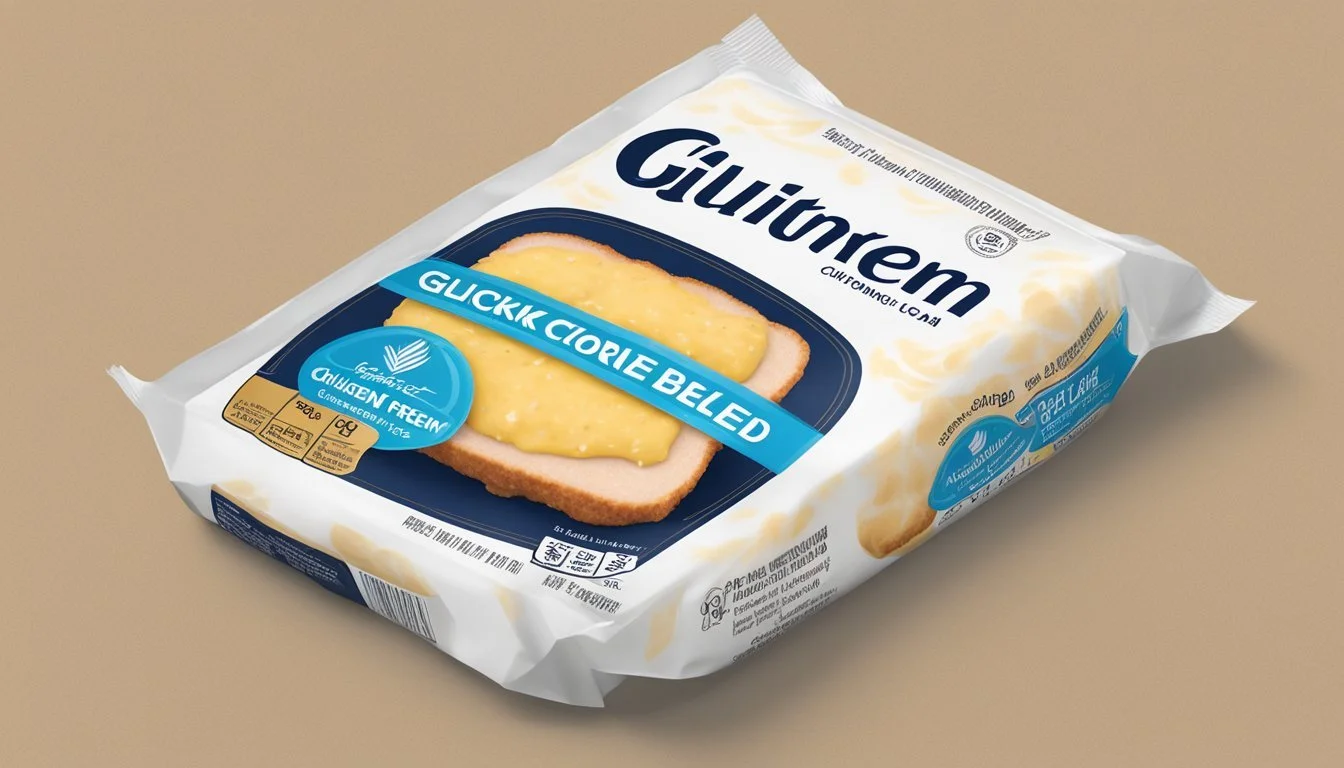How Long Does Gluten-Free Chicken Cordon Bleu Last?
Storage Tips and Shelf Life Explained
When you make a delicious batch of gluten-free chicken cordon bleu, it’s natural to wonder how long you can savor this delightful dish. Storing it properly is crucial to maintain its taste and safety. Gluten-free chicken cordon bleu can last up to 3-4 days in the refrigerator when stored in an airtight container.
For those looking to extend its shelf life, freezing becomes an option. Properly wrapped and stored in a freezer, gluten-free chicken cordon bleu can be preserved for up to 2-3 months without losing quality. Reheating is simple, whether using an oven or an air fryer, thus retaining its crispy exterior and succulent interior.
By knowing these storage tips, not only can you enjoy your gluten-free chicken cordon bleu longer, but you can also prevent food waste. This ensures that every bite remains as delightful as the first, making your efforts in the kitchen truly worthwhile.
What Is Chicken Cordon Bleu?
Chicken Cordon Bleu is a classic dish made by butterflying chicken breasts. Once the chicken breasts are cut thin and flat, they are filled with a slice of ham and cheese.
The edges of the chicken are then folded over the filling and secured, usually with toothpicks.
The chicken is coated by first dipping it into beaten eggs, followed by dredging in bread crumbs or a mixture of gluten-free flour, salt, and pepper.
For a gluten-free version, almond flour or other gluten-free bread crumbs are used instead of traditional wheat-based crumbs.
Chicken Cordon Bleu is cooked by baking in an oven, typically preheated to 350 degrees, until the internal temperature of the rolls reaches 165º F.
In some recipes, it can be cooked using an air fryer. In this case, the chicken is sprayed lightly with oil and cooked at 360º F for about 12 to 17 minutes.
The dish is known for its crispy exterior combined with the savory and creamy filling of ham and cheese. This combination creates a rich and flavorful meal.
Cheese options can vary but are often Swiss or Gruyère, providing a mild yet distinct flavor that complements the salted ham and seasoned chicken.
Salt, pepper, and sometimes additional seasonings like Italian seasoning, garlic powder, or onion powder may be used to enhance the flavor.
Chicken Cordon Bleu's preparation steps ensure a well-balanced mix of textures and flavors, resulting in a beloved dish that satisfies a wide range of palates.
Ingredients for Gluten-Free Chicken Cordon Bleu
When preparing Gluten-Free Chicken Cordon Bleu, selecting high-quality ingredients is crucial for taste and texture. The following subsections will guide you through the essential components, ensuring each choice enhances your dish.
Choosing the Right Chicken Breasts
Opt for boneless, skinless chicken breasts. They should be fresh and of a substantial size to adequately hold the stuffing.
Butterfly the chicken breasts to create thin, even slices. This ensures the meat cooks thoroughly and evenly.
The most tender cuts come from organic or free-range sources. They're generally more flavorful and juicy.
Selecting Gluten-Free Flours
Gluten-free flours are crucial for coating the chicken. Use a combination of almond flour, potato starch, and a bit of onion powder for seasoning.
Almond flour adds a nutty flavor, while potato starch provides the desired crispiness. Mix them well to create a balanced coating.
Ensure the flours are certified gluten-free to avoid contamination. This is especially important for those with severe gluten sensitivities.
Types of Cheese Suitable for the Recipe
Traditional Chicken Cordon Bleu uses Swiss cheese, but Provolone cheese is also an excellent choice.
Swiss cheese melts well and has a mild, slightly nutty flavor. Provolone, on the other hand, is slightly sharper and melts to a creamy texture.
Select cheese slices that are thin enough to fit inside the chicken without overpowering it but thick enough to provide a rich taste.
Ham Options for Stuffing
The choice of ham can significantly affect the overall taste. Opt for thinly sliced, high-quality ham such as prosciutto or black forest ham.
These varieties have a robust flavor that complements the chicken and cheese.
Ensure the ham is gluten-free by checking labels carefully. Some processed hams might contain gluten-containing additives.
Egg Wash and Other Binding Agents
An egg wash is essential for binding the breadcrumbs to the chicken. Use well-beaten eggs, perhaps mixed with a bit of water or milk.
This helps the flours adhere better. Ensure the eggs are fresh for the best texture.
To further enhance the coating, mix the egg wash with a bit of seasoning like garlic powder or onion powder.
Step-by-Step Directions for Gluten-Free Chicken Cordon Bleu
Creating gluten-free chicken cordon bleu involves specific steps including preparing the chicken, assembling the layers, breading with gluten-free crumbs, and cooking to the correct internal temperature.
Preparing the Chicken
Start by butterflying the chicken breasts. This means slicing them in half horizontally but not all the way through, creating a pocket for the filling. Once butterflied, use a meat mallet to pound the chicken breasts until they are evenly thin, which helps them cook evenly. Sprinkle each piece with salt and pepper to season.
Helpful Tip: Cover the chicken with plastic wrap while pounding to avoid mess and ensure an even thickness.
Assembling the Layers
Lay out the pounded chicken breasts on a clean surface. On each breast, place a slice of gluten-free cheese and a slice of ham, ensuring they are within ½ inch of the edges. Fold the chicken edges over the filling to enclose it, securing with toothpicks to hold the layers together.
Pro Tip: Use toothpicks at an angle to better keep the layers intact during cooking.
Breading with Gluten-Free Crumbs
Prepare the breading by mixing gluten-free bread crumbs with Italian seasoning and paprika in a shallow dish. In another shallow dish, whisk eggs with a little water or milk to create an egg wash.
Dip each chicken breast in the egg wash first and then coat thoroughly with the bread crumb mixture, ensuring a even and thorough coating.
Key Advice: Press the bread crumbs firmly onto the chicken to ensure they stick well.
Cooking to the Right Internal Temperature
For air frying, preheat your air fryer to 360º F. Lightly spray the fryer basket with oil, place the breaded chicken in the basket, and mist the chicken with oil. Cook for 12 minutes, then turn the chicken over and cook another 5 minutes.
For oven baking, preheat the oven to 350 degrees and prepare a greased casserole dish. Bake the chicken for 30-35 minutes.
Always check with a meat thermometer to confirm the internal temperature reaches 165º F.
Safety Tip: Ensure no pink meat remains and juices run clear to confirm doneness.
Proper Storage of Gluten-Free Chicken Cordon Bleu
Proper storage of gluten-free chicken cordon bleu ensures safety and preserves the dish's taste and texture. The following guidelines cover the best practices for refrigeration and freezing.
Refrigeration Guidelines
Cooked gluten-free chicken cordon bleu should be refrigerated within two hours of cooking to maintain food safety. Use airtight containers or tightly wrap the chicken in aluminum foil or plastic wrap to prevent exposure to air and moisture.
Store leftovers on the top shelf of the refrigerator to keep them at a consistent cold temperature. The internal refrigerator temperature should be set to 40º F (4º C) or below to inhibit bacterial growth. Properly refrigerated chicken cordon bleu can last 3-4 days.
Always check the internal temperature of the chicken before storing. It should be at least 165º F (74º C). Use a food thermometer to verify this. For best quality, reheat in the oven on a baking sheet at 350º F (175º C) until the internal temperature again reaches 165º F.
Freezing and Thawing Techniques
Place chicken cordon bleu in airtight, freezer-safe containers, or wrap each piece in heavy-duty aluminum foil, followed by a plastic freezer bag. Label each package with the date to keep track of storage time.
For optimal quality, gluten-free chicken cordon bleu can be frozen for up to 3 months. To thaw, transfer the chicken from the freezer to the refrigerator. This slow thawing method maintains the dish's texture and flavor.
Avoid thawing at room temperature to prevent bacterial growth. Once fully thawed, reheat in the oven at 350º F (175º C) on a baking sheet. Check that the internal temperature reaches 165º F (74º C) before serving.
Reheating Gluten-Free Chicken Cordon Bleu
Reheating gluten-free chicken cordon bleu can be done effectively using an oven or a microwave. Each method has its own advantages for achieving the right texture and ensuring food safety.
Oven Reheating Method
Using an oven is ideal to maintain the crispy texture of gluten-free chicken cordon bleu. Preheat the oven to 350°F (175°C). Place the chicken on a baking sheet lined with parchment paper or foil.
Cover the chicken lightly with foil to prevent it from drying out. Bake for 15-20 minutes, or until the internal temperature reaches 165°F (73.9°C). For an extra crispy finish, remove the foil for the last 5 minutes of baking.
Use a meat thermometer to check the internal temperature to ensure it’s heated through properly. This method is best for retaining the dish’s original texture and flavor.
Microwave Reheating Tips
The microwave is a quicker option but may result in a less crispy texture. Place the chicken on a microwave-safe plate. Cover with a microwave-safe lid or a damp paper towel to retain moisture.
Heat on medium power for 2-3 minutes. Check the internal temperature with a meat thermometer to ensure it reaches 165°F (73.9°C). If it’s not hot enough, continue heating in 30-second intervals.
For a slightly better texture, use a microwave crisper tray, if available. This can help maintain some crispiness while reheating. Crisper trays are specifically designed to recreate oven-like heating.
Nutritional Information
A serving of gluten-free chicken cordon bleu provides a range of nutrients. It's important to understand the caloric content and the breakdown of macronutrients to make informed dietary choices.
Caloric Content Overview
A typical serving of gluten-free chicken cordon bleu contains around 400-450 calories. This count can vary based on ingredient choices and cooking methods.
A significant portion of these calories comes from the proteins in the chicken and the fats present in the cheese and ham filling. Cooking oils or methods (like air frying or baking) can also impact the caloric content.
The serving size typically correlates to a single chicken breast, but portion control is essential for accurate calorie tracking.
Macronutrient Breakdown
Protein:
Per serving, the protein content usually ranges between 25-30 grams. This helps in muscle repair and maintenance.
Fat:
Total fat content per serving can be around 20-25 grams, with 8-10 grams being saturated fat. The presence of cheese and ham contributes to these values.
Carbohydrates:
Carbs are relatively low, around 10-15 grams per serving, primarily from bread crumbs or coatings.
Cholesterol and Sodium:
The dish contains about 80-100 milligrams of cholesterol.
Sodium content can be higher due to cheese and ham, often around 700-800 milligrams per serving.
Accurate nutritional tracking requires considering ingredient labels and preparation methods.
Pairing and Serving Suggestions
When serving gluten-free chicken cordon bleu, selecting complementary sides and beverages can enhance the meal experience. The following suggestions cover a variety of choices including side dishes and wine pairings.
Side Dishes
Mashed Potatoes make an excellent pairing due to their creamy texture, which balances well with the crispy exterior and rich filling of the chicken cordon bleu.
Steamed Vegetables like carrots, green beans, or broccoli provide a light and healthy contrast. These can be seasoned with garlic and a touch of olive oil to enhance their flavor.
Salads, such as a mixed green or Caesar salad, work well by adding freshness and a crunchy texture. Consider incorporating ingredients like cherry tomatoes, cucumbers, and a simple vinaigrette.
Wine Pairing
Selecting the right wine can elevate your dining experience. Chardonnay is a top choice; its buttery notes complement the ham and cheese in the chicken cordon bleu.
For red wine lovers, Pinot Noir offers a lighter profile that pairs well without overpowering the dish’s flavors.
Sparkling Wine or Champagne can also be considered. The effervescence helps to cleanse the palate, making it a delightful choice, especially for special occasions.
Appropriate Condiments
Choose condiments that enhance the flavors without overwhelming them. Dijon Mustard is a classic option that pairs well with the ham and cheese inside the cordon bleu.
For a creamy element, consider a Garlic Aioli. This can be made by blending mayonnaise, minced garlic, and a splash of lemon juice.
A simple herb butter made with finely chopped parsley, chives, and softened butter can be used to complement the dish, adding a rich and aromatic touch.
Considerations for Individuals with Celiac Disease
Individuals with celiac disease need to be highly cautious about cross-contamination when preparing and storing gluten-free Chicken Cordon Bleu. Even small amounts of gluten can trigger symptoms, so maintaining a strict gluten-free environment is crucial.
Steps to Minimize Cross-Contamination:
Use separate utensils: Always use separate knives, cutting boards, and cooking utensils for gluten-free foods.
Clean surfaces thoroughly: Ensure all cooking surfaces are cleaned properly before preparing gluten-free dishes.
Store separately: Keep gluten-free Chicken Cordon Bleu in separate, clearly labeled containers to prevent accidental mix-ups.
Safe Storage Practices
For those with celiac disease, proper storage of gluten-free Chicken Cordon Bleu is essential to maintaining its safety and quality. Refrigerate within two hours of cooking and consume within 3-4 days.
Refrigeration Tips:
Store in airtight containers to prevent contamination.
Label containers with the date of preparation.
Freezing Tips:
Wrap each piece individually in plastic wrap and place in a freezer-safe bag.
Consume within 1-2 months for best quality.
Checking for Cross-Contamination
Always check labels on all ingredients, including ham and cheese, to ensure they are certified gluten-free. When dining out or buying pre-made items, ensure they come from dedicated gluten-free establishments.
Tips for Ensuring Gluten-Free Safety
Proper handling and preparation are crucial for maintaining the safety of gluten-free chicken cordon bleu.
Cross-Contamination: Always use separate utensils, cutting boards, and cooking surfaces. Wash hands thoroughly before working with gluten-free ingredients. This minimizes the risk of cross-contamination, which is essential for people with celiac disease.
Ingredient Selection: Choose verified gluten-free products, including flour, breadcrumbs, and seasonings. Products labeled gluten-free ensure they meet the necessary safety standards.
Storage: Store gluten-free chicken separately from gluten-containing items. Use airtight containers to avoid any accidental exposure to gluten.
An overview of safe practices:
Task Gluten-Free Safety Tip Preparing Ingredients Use separate utensils and equipment Cooking Clean surfaces thoroughly before cooking Storing Use airtight containers for gluten-free items Shopping Verify products are labeled gluten-free
By following these tips, the gluten-free chicken cordon bleu can be enjoyed safely, minimizing any risk for those with gluten sensitivities.








